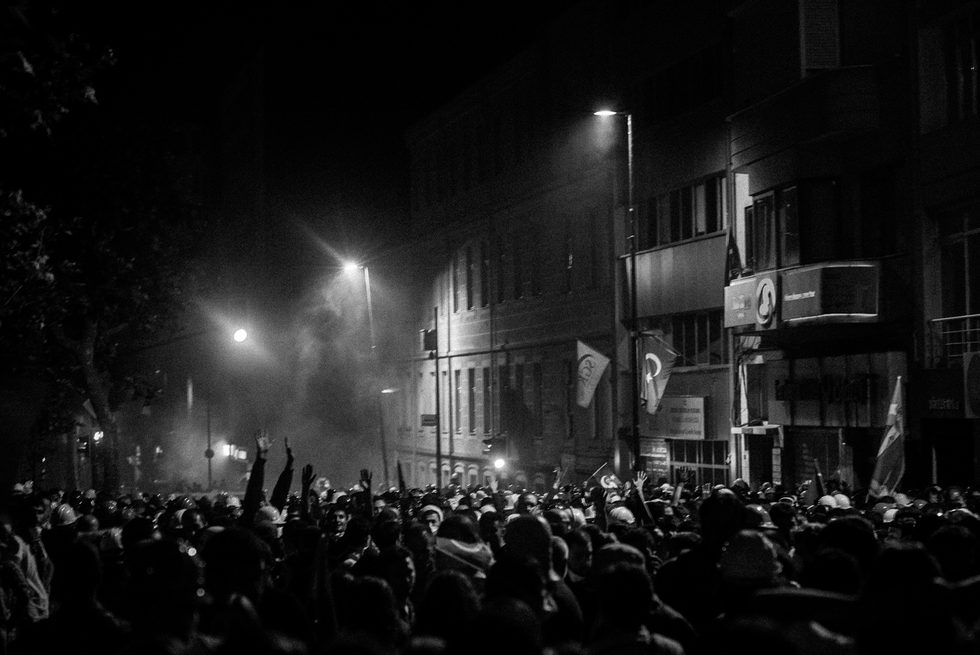Kissing the Mahrem in Ankara
From the Series: An Impromptu Uprising: Ethnographic Reflections on the Gezi Park Protests in Turkey
From the Series: An Impromptu Uprising: Ethnographic Reflections on the Gezi Park Protests in Turkey

On May 25, 2013, Ankara’s Kurtuluş subway station witnessed Turkey’s first kissing protest. The demonstration was called in response to a public announcement one week earlier at the very same station, a statement that warned couples in the subway to “please behave in accordance with public moral codes.” The protest was organized and spread over social media, with demonstrators announcing, “We will be kissing in Kurtuluş subway!” A counter-protest was immediately engineered by the Ankara youth branch of the AKP to “Stop the Acts against Public Moral Codes!” On the day of the protest, the angry counter-protesters brought out knives during the ensuing clash, and police intervened to quell the rising tensions. That day, from 6:00 to 7:00 PM, there were concentric layers of people on the scene: the kissing protesters, the media, a few citizens present to witness and record the public kissing, the police, the enraged “moral code defenders,” and the curious public surrounding the hubbub. From these screening layers of crowd and strife, two fragments from the television news stuck in my mind: kissing couples surrounded by photographers, and bloodstains on the subway steps where a demonstrator was stabbed by an angry “moral code defender.” What remains baffling about this scene is that an instant of public sexual-and-intimate expression could be met with such violence. What was at stake to have sparked such a disgraceful act of rage?
Berlant and Warner (1998) discuss sex and sexuality as always “mediated by publics” and argue that heterosexual culture creates privacy in order to identify itself, operate, and preserve its own coherence: “Heterosexual culture achieves much of its metacultural intelligibility through the ideologies and institutions of intimacy” (553). Kissing protests are a well-known part of global LGBT activism, taking the form of same-sex kissings that trigger parallel “out-of-place” perceptions (Hubbard 2012) and are considered a “threatening act” against public norms (Morris and Sloop 2006). Although there was one female-couple kissing as part of the protest in Ankara, they appeared towards the end of the protest and were not the main issue of vexation. Following Berlant’s terminology, the Ankara kissing protest reveals how conflicting institutions of privacy are at play in Turkey: a traditional culture of mahremiyet against an emergent notion of privacy.
The word mahrem literally means forbidden, but the concept mahremiyet is not translatable into English, as it simultaneously means privacy and intimacy. In everyday life, the word commonly denotes a private, often sexual, realm in the lives of individuals, couples, or families, and is therefore confined by normative boundaries that often work in favor of hegemonic masculinity. Mahremiyet is defined, made, and remade in daily life, as part of the institutions of privacy that Berlant (2000, 286, 288) says are “created to stabilize” and “normalize particular forms of knowledge and practice and to create compliant subjects.” It refers to a notion of privacy and confidentiality that insiders are expected to preserve and outsiders are expected not to violate. Gaze and gazing at the intimate becomes interpreted as a sexual script. In mahremiyet, covering and hiding the mahrem against the gaze of the sexual superior (male over female, outsider over insider) is the main component of the gazing relationship. The curious gaze that has the power to penetrate, to monitor, and to be hidden from is therefore a micro-level reflection of the cultural heterosexual imagination of the masculine position in this institution of intimacy. A public display of a mahrem sexual subject or act undermines the power of the masculine position in this equation. The Ankara kissing protest that publicly averts the gender binary, simultaneously steals away the penetrating role and disempowers a penetrating, active, and masculine type of sexuality by pushing it to the other end of the spectrum: penetrated, passive, and feminine. Considering how the troubled normative boundaries result in violent rage in the context of Turkey, with honor crimes and trans murders, a political protest against state intervention to contemporary and secular forms of intimacy and privacy, in the case of Ankara kissing protest, becomes a new form of the abject and therefore is confronted with the violent face of heteronormative privacy.
Lauren Berlant, Intimacy, Chicago: University of Chicago Press 2000.
Lauren Berlant and Michael Warner, “Sex in Public,” Critical Inquiry 24, no. 2 (1998): 547–66.
Nilüfer Göle, The Forbidden Modern: Civilization and Veiling, Ann Arbor: University of Michigan Press, 1996.
Phil Hubbard, “Kissing is Not a Universal Right: Sexuality, Law and the Scales of Citizenship.” Geoforum 24 (2012): 224–32.
Charles E. Morris and John M. Sloop, “‘What Lips these Lips Have Kissed’: Refiguring the Politics of Queer Public Kissing,” Communication and Critical/Cultural Studies 3, no. 1 (2006): 1–26.